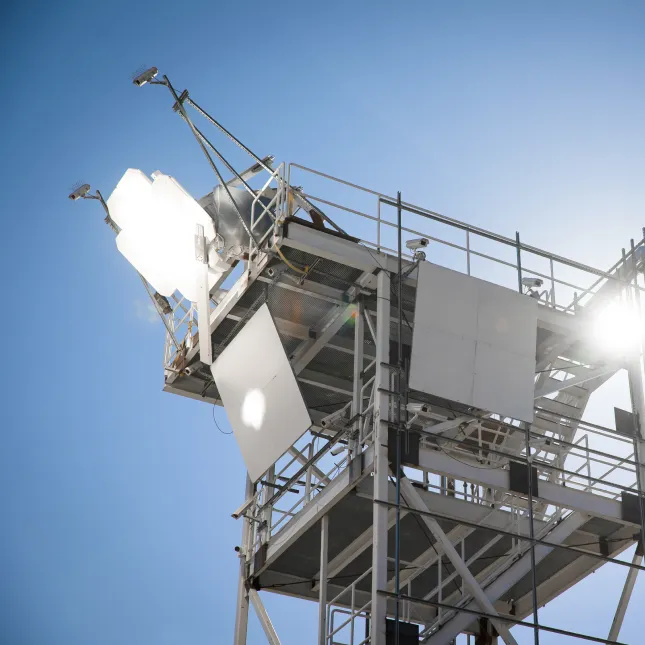Concentrating solar describes a range of technologies that collect and concentrate sunlight in order to make use of its energy by converting it to heat. The idea of concentrating solar goes back at least to Archimedes, who may have (historians like to argue about this) used an array of mirrors to focus sunlight on approaching warships and setting fire to them during the Siege of Syracuse over two thousand years ago. Concentrating solar found some interest after the industrial revolution, and in 1866, Augustin Mouchot used a parabolic mirror to boil water and drive a steam engine for the first time.
More recently, since the 1980s, concentrating solar has been in use around the world for producing electricity, this is called Concentrating Solar Power (CSP). CSP has been implemented using a variety of different technologies. The two most common configurations are known as troughs and towers.
 In a trough (or parabolic trough) plant, curved mirrors are arranged into long linear rows, and rotate to track the sun in a single axis. The curvature of the mirrors and the tracking motion work together to concentrate the sunlight onto a collecting element that absorbs the sunlight and transfers the energy as heat into a working fluid. That hot fluid is then used to boil water into steam, which in turn drives a steam turbine to produce electricity.
In a trough (or parabolic trough) plant, curved mirrors are arranged into long linear rows, and rotate to track the sun in a single axis. The curvature of the mirrors and the tracking motion work together to concentrate the sunlight onto a collecting element that absorbs the sunlight and transfers the energy as heat into a working fluid. That hot fluid is then used to boil water into steam, which in turn drives a steam turbine to produce electricity.
 In a tower plant, flat (or more gently curved) mirrors are individually tracked relative to the sun, such that each mirror directs its reflection to a common focal point at the top of a large tower. Atop that tower is a solar receiver, which absorbs the sunlight and transfers it as heat into a working medium, which could include air, water, or very small particles. From that point on, the process is similar to that of a trough plant, with the hot medium being used to boil water into steam and driving a steam turbine to produce electricity.
An interesting aspect of concentrating solar, which differentiates it from photovoltaic solar power, is that the heat generated by concentrated sunlight can potentially be used for purposes other than electricity generation. This is called Concentrating Solar Thermal (CST). Worldwide, 75% of energy consumed is heat from the burning of fuels like coal, diesel, and natural gas. CST can address much of this 75% by using concentrated solar to make heat from the sun. Using CST in this way, for industrial process heat applications, would significantly reduce CO2 emissions and greatly contribute to solving climate change. Unfortunately, there are relatively few examples of this being put into practice.
In a tower plant, flat (or more gently curved) mirrors are individually tracked relative to the sun, such that each mirror directs its reflection to a common focal point at the top of a large tower. Atop that tower is a solar receiver, which absorbs the sunlight and transfers it as heat into a working medium, which could include air, water, or very small particles. From that point on, the process is similar to that of a trough plant, with the hot medium being used to boil water into steam and driving a steam turbine to produce electricity.
An interesting aspect of concentrating solar, which differentiates it from photovoltaic solar power, is that the heat generated by concentrated sunlight can potentially be used for purposes other than electricity generation. This is called Concentrating Solar Thermal (CST). Worldwide, 75% of energy consumed is heat from the burning of fuels like coal, diesel, and natural gas. CST can address much of this 75% by using concentrated solar to make heat from the sun. Using CST in this way, for industrial process heat applications, would significantly reduce CO2 emissions and greatly contribute to solving climate change. Unfortunately, there are relatively few examples of this being put into practice.
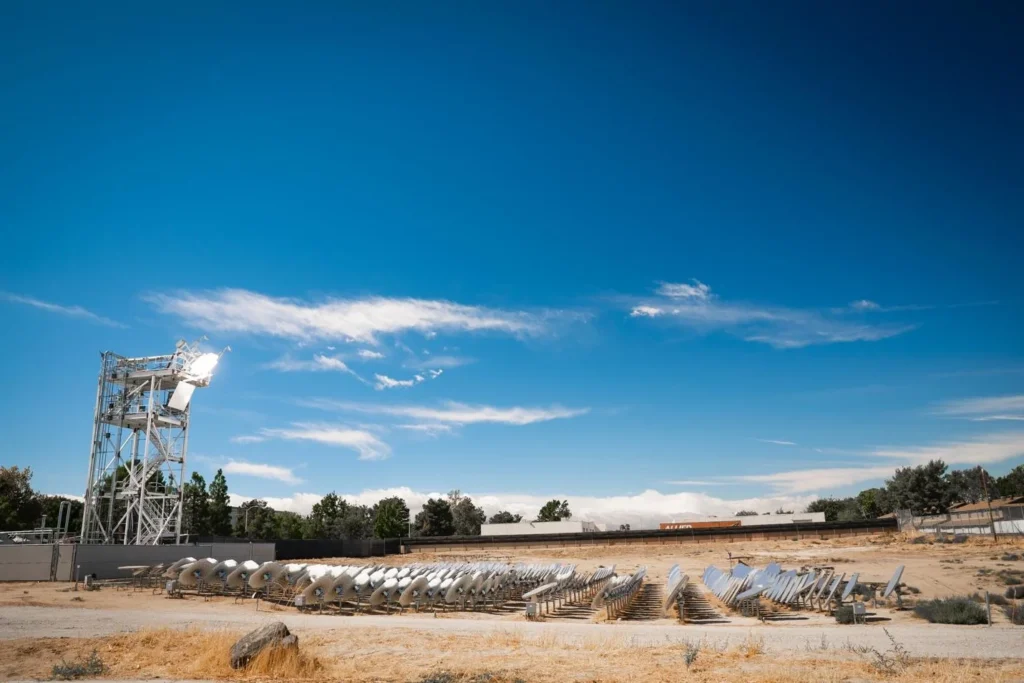 The core of Heliogen’s technology is a tower-based concentrating solar thermal (CST) system that is made up of an array of computer-controlled mirrors called heliostats and a receiver on top of the tower that accepts the concentrated sunlight. Our system is constructed and controlled to achieve very high optical accuracy at lower cost. High optical accuracy allows Heliogen to generate high temperatures at the receiver (~1000ºC) efficiently, while the cost effectiveness, of course, makes the system more commercially viable for our customers. We achieve this through the innovative design of both the heliostat hardware and the heliostat field control system.
The core of Heliogen’s technology is a tower-based concentrating solar thermal (CST) system that is made up of an array of computer-controlled mirrors called heliostats and a receiver on top of the tower that accepts the concentrated sunlight. Our system is constructed and controlled to achieve very high optical accuracy at lower cost. High optical accuracy allows Heliogen to generate high temperatures at the receiver (~1000ºC) efficiently, while the cost effectiveness, of course, makes the system more commercially viable for our customers. We achieve this through the innovative design of both the heliostat hardware and the heliostat field control system.
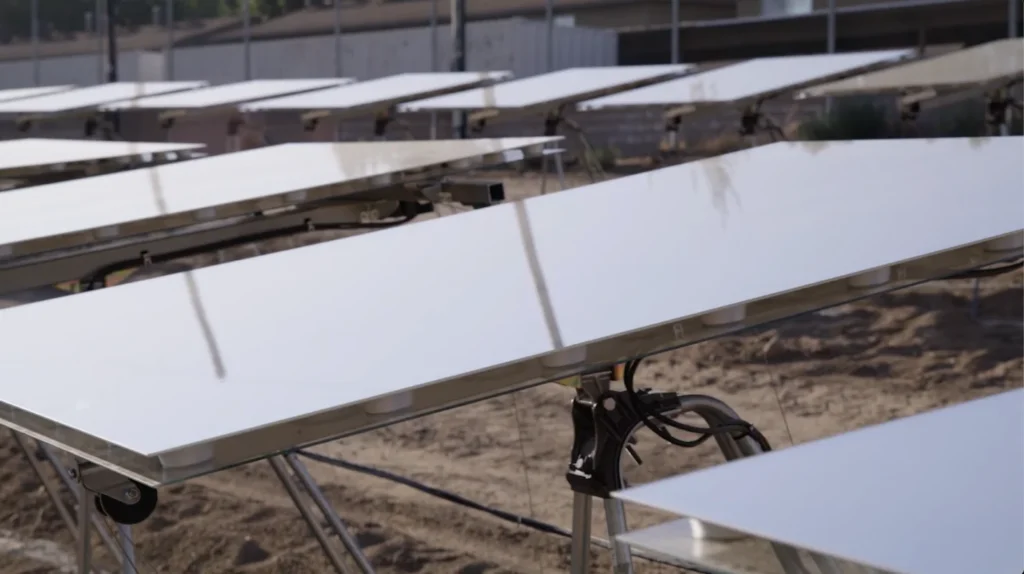 Heliogen’s heliostats are small – around 2 square meters, or slightly smaller than a standard solar panel. This differs greatly from conventional heliostats, which may range anywhere from 20 to 150 square meters. Using small heliostats provides an advantage in the optical performance because larger mirrors suffer from optical aberrations – beam distortion caused whenever the sun isn’t perfectly aligned with the mirror (which is essentially all the time in a heliostat field). The drawbacks historically associated with small heliostats include manufacturing cost and calibration/control. Heliogen has minimized the manufacturing cost of our small heliostats by optimizing the design for high-volume, highly automated production techniques (such as injection molding plastics, die-casting aluminum alloys, etc.) and by minimizing the precision with which the heliostats need to be built and installed in the field. This allows for cost-effective production and fast installation, keeping costs lower. And to address the calibration and control challenges of small heliostats, we’ve developed and patented an innovative computer vision closed-loop tracking control system. This allows heliostats to be installed and manufactured quicker and for the control system to detect and correct their actual tracking position in real-time during operation.
Heliogen’s heliostats are small – around 2 square meters, or slightly smaller than a standard solar panel. This differs greatly from conventional heliostats, which may range anywhere from 20 to 150 square meters. Using small heliostats provides an advantage in the optical performance because larger mirrors suffer from optical aberrations – beam distortion caused whenever the sun isn’t perfectly aligned with the mirror (which is essentially all the time in a heliostat field). The drawbacks historically associated with small heliostats include manufacturing cost and calibration/control. Heliogen has minimized the manufacturing cost of our small heliostats by optimizing the design for high-volume, highly automated production techniques (such as injection molding plastics, die-casting aluminum alloys, etc.) and by minimizing the precision with which the heliostats need to be built and installed in the field. This allows for cost-effective production and fast installation, keeping costs lower. And to address the calibration and control challenges of small heliostats, we’ve developed and patented an innovative computer vision closed-loop tracking control system. This allows heliostats to be installed and manufactured quicker and for the control system to detect and correct their actual tracking position in real-time during operation.
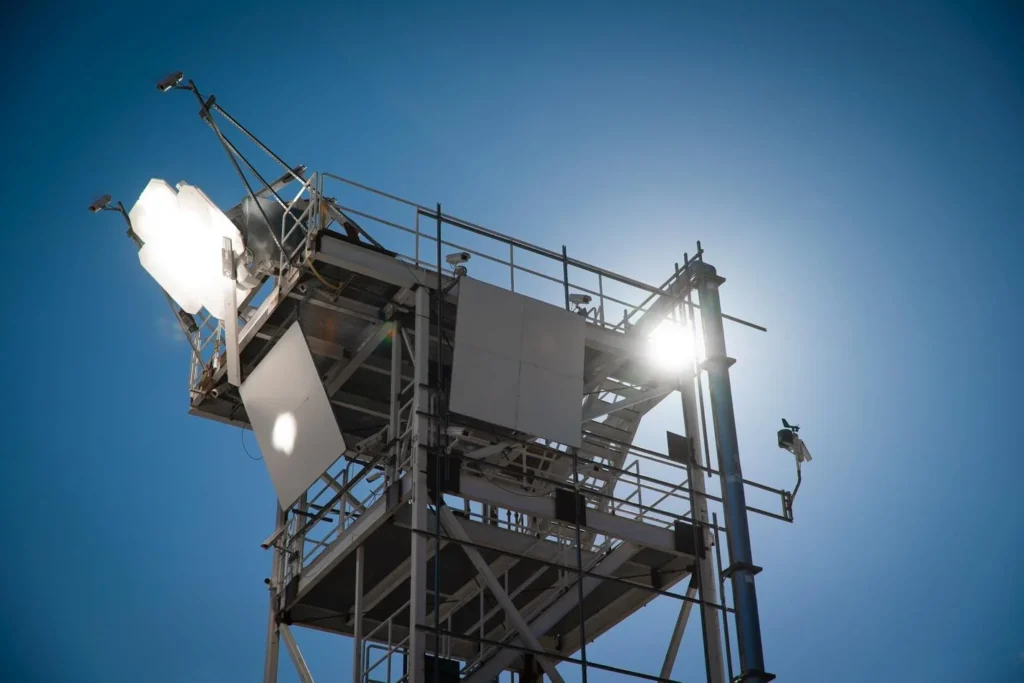 Together, these advancements in small heliostat manufacturing and control allow Heliogen to create carbon-free steam. HelioSteam provides a green alternative for industrial process steam. This ready-to-deploy solution lowers fossil fuel dependence to help industrial customers achieve their climate targets. With the superior optical accuracy of Heliogen’s heliostat field, we’re able to efficiently reach exact temperatures. In this way, Heliogen is opening up a broad array of industrial processes from drying, distilling in the food and beverage industry, to calcining, reforming, and ore roasting in industries such as cement, refining, and mining.
Together, these advancements in small heliostat manufacturing and control allow Heliogen to create carbon-free steam. HelioSteam provides a green alternative for industrial process steam. This ready-to-deploy solution lowers fossil fuel dependence to help industrial customers achieve their climate targets. With the superior optical accuracy of Heliogen’s heliostat field, we’re able to efficiently reach exact temperatures. In this way, Heliogen is opening up a broad array of industrial processes from drying, distilling in the food and beverage industry, to calcining, reforming, and ore roasting in industries such as cement, refining, and mining.
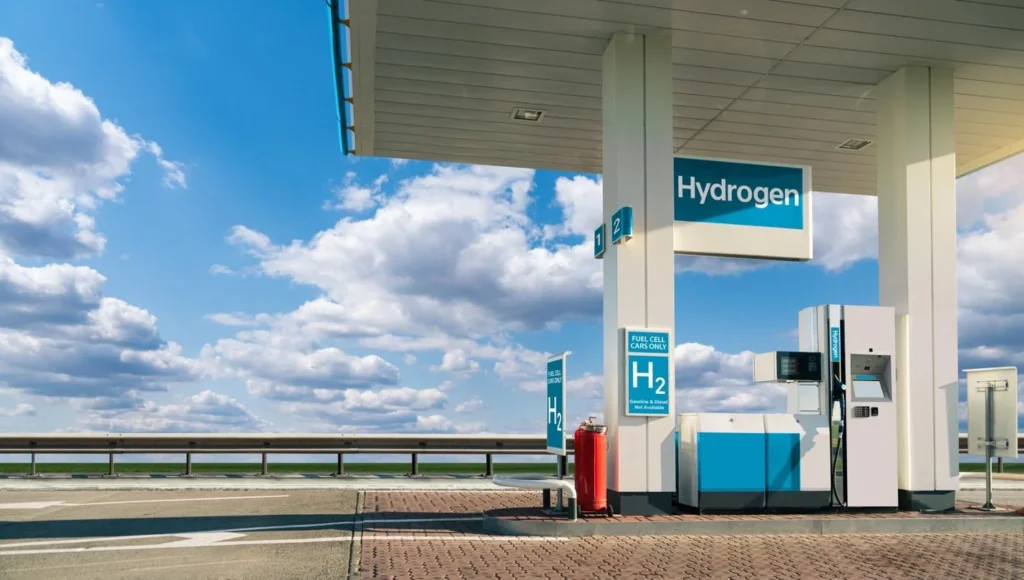 One subset of industrial process heat applications that is of particular interest is the production of synthetic fuels. Fuel synthesis involves the production of chemical fuels (typically hydrogen, methane, or liquid hydrocarbons) from non-fuel feedstocks such as carbon dioxide and water. Synthetic fuel holds great promise in our energy future, as a means of enjoying the benefits and conveniences of fossil fuels, but without the fossil fuels and associated environmental impact. This is an energy-intensive process however, so producing clean fuels requires the use of a clean energy source to drive the thermochemical reactions. This is where Heliogen’s HelioFuel™ solution comes in.
One subset of industrial process heat applications that is of particular interest is the production of synthetic fuels. Fuel synthesis involves the production of chemical fuels (typically hydrogen, methane, or liquid hydrocarbons) from non-fuel feedstocks such as carbon dioxide and water. Synthetic fuel holds great promise in our energy future, as a means of enjoying the benefits and conveniences of fossil fuels, but without the fossil fuels and associated environmental impact. This is an energy-intensive process however, so producing clean fuels requires the use of a clean energy source to drive the thermochemical reactions. This is where Heliogen’s HelioFuel™ solution comes in.
 In a trough (or parabolic trough) plant, curved mirrors are arranged into long linear rows, and rotate to track the sun in a single axis. The curvature of the mirrors and the tracking motion work together to concentrate the sunlight onto a collecting element that absorbs the sunlight and transfers the energy as heat into a working fluid. That hot fluid is then used to boil water into steam, which in turn drives a steam turbine to produce electricity.
In a trough (or parabolic trough) plant, curved mirrors are arranged into long linear rows, and rotate to track the sun in a single axis. The curvature of the mirrors and the tracking motion work together to concentrate the sunlight onto a collecting element that absorbs the sunlight and transfers the energy as heat into a working fluid. That hot fluid is then used to boil water into steam, which in turn drives a steam turbine to produce electricity.
 In a tower plant, flat (or more gently curved) mirrors are individually tracked relative to the sun, such that each mirror directs its reflection to a common focal point at the top of a large tower. Atop that tower is a solar receiver, which absorbs the sunlight and transfers it as heat into a working medium, which could include air, water, or very small particles. From that point on, the process is similar to that of a trough plant, with the hot medium being used to boil water into steam and driving a steam turbine to produce electricity.
An interesting aspect of concentrating solar, which differentiates it from photovoltaic solar power, is that the heat generated by concentrated sunlight can potentially be used for purposes other than electricity generation. This is called Concentrating Solar Thermal (CST). Worldwide, 75% of energy consumed is heat from the burning of fuels like coal, diesel, and natural gas. CST can address much of this 75% by using concentrated solar to make heat from the sun. Using CST in this way, for industrial process heat applications, would significantly reduce CO2 emissions and greatly contribute to solving climate change. Unfortunately, there are relatively few examples of this being put into practice.
In a tower plant, flat (or more gently curved) mirrors are individually tracked relative to the sun, such that each mirror directs its reflection to a common focal point at the top of a large tower. Atop that tower is a solar receiver, which absorbs the sunlight and transfers it as heat into a working medium, which could include air, water, or very small particles. From that point on, the process is similar to that of a trough plant, with the hot medium being used to boil water into steam and driving a steam turbine to produce electricity.
An interesting aspect of concentrating solar, which differentiates it from photovoltaic solar power, is that the heat generated by concentrated sunlight can potentially be used for purposes other than electricity generation. This is called Concentrating Solar Thermal (CST). Worldwide, 75% of energy consumed is heat from the burning of fuels like coal, diesel, and natural gas. CST can address much of this 75% by using concentrated solar to make heat from the sun. Using CST in this way, for industrial process heat applications, would significantly reduce CO2 emissions and greatly contribute to solving climate change. Unfortunately, there are relatively few examples of this being put into practice.
Heliogen’s Technology
Heliogen is a clean energy company focused on eliminating the need for fossil fuels. By cost-effectively using heat from the sun to replace fossil fuels, Heliogen enables our customers to meet their sustainability goals and help mitigate climate change without hurting their bottom line. The core of Heliogen’s technology is a tower-based concentrating solar thermal (CST) system that is made up of an array of computer-controlled mirrors called heliostats and a receiver on top of the tower that accepts the concentrated sunlight. Our system is constructed and controlled to achieve very high optical accuracy at lower cost. High optical accuracy allows Heliogen to generate high temperatures at the receiver (~1000ºC) efficiently, while the cost effectiveness, of course, makes the system more commercially viable for our customers. We achieve this through the innovative design of both the heliostat hardware and the heliostat field control system.
The core of Heliogen’s technology is a tower-based concentrating solar thermal (CST) system that is made up of an array of computer-controlled mirrors called heliostats and a receiver on top of the tower that accepts the concentrated sunlight. Our system is constructed and controlled to achieve very high optical accuracy at lower cost. High optical accuracy allows Heliogen to generate high temperatures at the receiver (~1000ºC) efficiently, while the cost effectiveness, of course, makes the system more commercially viable for our customers. We achieve this through the innovative design of both the heliostat hardware and the heliostat field control system.
 Heliogen’s heliostats are small – around 2 square meters, or slightly smaller than a standard solar panel. This differs greatly from conventional heliostats, which may range anywhere from 20 to 150 square meters. Using small heliostats provides an advantage in the optical performance because larger mirrors suffer from optical aberrations – beam distortion caused whenever the sun isn’t perfectly aligned with the mirror (which is essentially all the time in a heliostat field). The drawbacks historically associated with small heliostats include manufacturing cost and calibration/control. Heliogen has minimized the manufacturing cost of our small heliostats by optimizing the design for high-volume, highly automated production techniques (such as injection molding plastics, die-casting aluminum alloys, etc.) and by minimizing the precision with which the heliostats need to be built and installed in the field. This allows for cost-effective production and fast installation, keeping costs lower. And to address the calibration and control challenges of small heliostats, we’ve developed and patented an innovative computer vision closed-loop tracking control system. This allows heliostats to be installed and manufactured quicker and for the control system to detect and correct their actual tracking position in real-time during operation.
Heliogen’s heliostats are small – around 2 square meters, or slightly smaller than a standard solar panel. This differs greatly from conventional heliostats, which may range anywhere from 20 to 150 square meters. Using small heliostats provides an advantage in the optical performance because larger mirrors suffer from optical aberrations – beam distortion caused whenever the sun isn’t perfectly aligned with the mirror (which is essentially all the time in a heliostat field). The drawbacks historically associated with small heliostats include manufacturing cost and calibration/control. Heliogen has minimized the manufacturing cost of our small heliostats by optimizing the design for high-volume, highly automated production techniques (such as injection molding plastics, die-casting aluminum alloys, etc.) and by minimizing the precision with which the heliostats need to be built and installed in the field. This allows for cost-effective production and fast installation, keeping costs lower. And to address the calibration and control challenges of small heliostats, we’ve developed and patented an innovative computer vision closed-loop tracking control system. This allows heliostats to be installed and manufactured quicker and for the control system to detect and correct their actual tracking position in real-time during operation.
 Together, these advancements in small heliostat manufacturing and control allow Heliogen to create carbon-free steam. HelioSteam provides a green alternative for industrial process steam. This ready-to-deploy solution lowers fossil fuel dependence to help industrial customers achieve their climate targets. With the superior optical accuracy of Heliogen’s heliostat field, we’re able to efficiently reach exact temperatures. In this way, Heliogen is opening up a broad array of industrial processes from drying, distilling in the food and beverage industry, to calcining, reforming, and ore roasting in industries such as cement, refining, and mining.
Together, these advancements in small heliostat manufacturing and control allow Heliogen to create carbon-free steam. HelioSteam provides a green alternative for industrial process steam. This ready-to-deploy solution lowers fossil fuel dependence to help industrial customers achieve their climate targets. With the superior optical accuracy of Heliogen’s heliostat field, we’re able to efficiently reach exact temperatures. In this way, Heliogen is opening up a broad array of industrial processes from drying, distilling in the food and beverage industry, to calcining, reforming, and ore roasting in industries such as cement, refining, and mining.
 One subset of industrial process heat applications that is of particular interest is the production of synthetic fuels. Fuel synthesis involves the production of chemical fuels (typically hydrogen, methane, or liquid hydrocarbons) from non-fuel feedstocks such as carbon dioxide and water. Synthetic fuel holds great promise in our energy future, as a means of enjoying the benefits and conveniences of fossil fuels, but without the fossil fuels and associated environmental impact. This is an energy-intensive process however, so producing clean fuels requires the use of a clean energy source to drive the thermochemical reactions. This is where Heliogen’s HelioFuel™ solution comes in.
One subset of industrial process heat applications that is of particular interest is the production of synthetic fuels. Fuel synthesis involves the production of chemical fuels (typically hydrogen, methane, or liquid hydrocarbons) from non-fuel feedstocks such as carbon dioxide and water. Synthetic fuel holds great promise in our energy future, as a means of enjoying the benefits and conveniences of fossil fuels, but without the fossil fuels and associated environmental impact. This is an energy-intensive process however, so producing clean fuels requires the use of a clean energy source to drive the thermochemical reactions. This is where Heliogen’s HelioFuel™ solution comes in.
